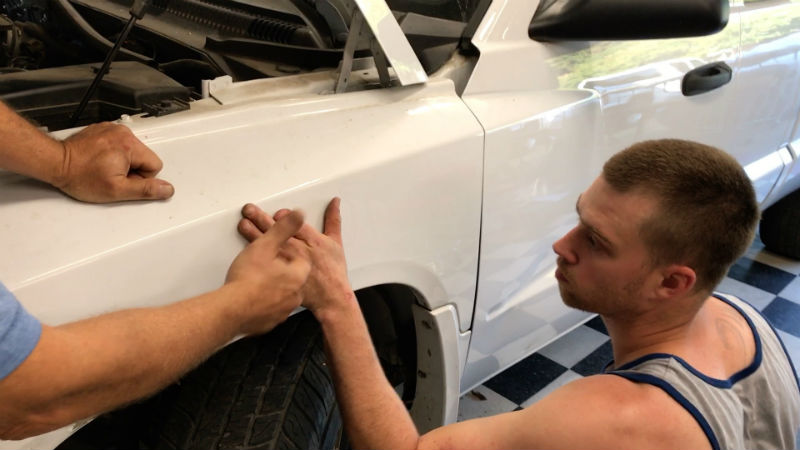Analysis of the techs dent repair technique. The tech is given two types of dents and trainer analyzes pushing technique, board or fixture placement, board or fixture movement anchoring, basic accuracy, head movement, baseline head movement, tool control, tool tip control, basic work technique, hand eye coordination, etc. This is NOT a test but a basic analysis of the techs proficiency level, and to determine areas that need work. This usually is a lot of fun for both trainee and trainer.
Some of the terms described here may not be familiar to you. Don't be intimidated. They are terms used by old school metal finishers and are given to describe a VERY EASY TO UNDERSTAND PROCESS.
Advanced Training One-Week Course Outline
 Analysis of the techs dent repair technique. The tech is given two types of dents and trainer analyzes pushing technique, board or fixture placement, board or fixture movement anchoring, basic accuracy, head movement, baseline head movement, tool control, tool tip control, basic work technique, hand eye coordination, etc. This is NOT a test but a basic analysis of the techs proficiency level, and to determine areas that need work. This usually is a lot of fun for both trainee and trainer.
Analysis of the techs dent repair technique. The tech is given two types of dents and trainer analyzes pushing technique, board or fixture placement, board or fixture movement anchoring, basic accuracy, head movement, baseline head movement, tool control, tool tip control, basic work technique, hand eye coordination, etc. This is NOT a test but a basic analysis of the techs proficiency level, and to determine areas that need work. This usually is a lot of fun for both trainee and trainer.
The technicians bad habits (if any) are discussed, and exercises are given to help eliminate these bad habits. This is essential to prepare student for more advanced methods. Habits that hinder accuracy, quality, and speed, must be eliminated as much as possible at this point.
Fog board basics and advanced fog board use. During this part the tech is dialed in to the optimum dent reading board for his needs. This may include a wide variety or combination of fog types from natural, pvc, various painted types, multiple gradient, light to medium diffused fog patterns, lined fog, and many others. Advanced fog board placement, multiple board use, switch reading, core reading, and crown reading is covered extensively.
Basic S.A.L.T. theory and principles are discussed and practiced.
Automotive sheet metal theory. This is one of the most important subjects covered. We teach you by class room and hands on exercises how sheet metal really responds to PDR. Many methods we use at TopGun are similar to the methods old school panel shapers used to repair panels, except we leave the paint undamaged of course. Many of these old school methods can be applied to PDR and are very important to learn if you want to do fast and quality repairs.
We find that this is probably the most misunderstood parts of PDR. Most technicians have little idea why metal acts the way it does or why they are many times surprised during large or complex dent repairs at how the metal reacts. This course wil take the mystery out of sheet metals behavior and you will fully understand how to repair complex dents, and move the metal the way the panel wants to be repaired. Most techs say this course totally changes the way they look at sheet metal, and the way they repair complex dents.
Advanced core removal and stretched metal dents are now covered extensively, with emphasis on accuracy, proper pushing, releasing, and visual cue interpretations. Theory is mixed with practice to make the process flow.
Basic and Advanced crease theory is covered with emphasis on different board placements and pressure area identification. Pressure release patterns, and accuracy is stressed.
Crown removal theory and practice with emphasis on different methods for releasing different types of crowns. Exercises are given to make this easily understandable. Identifying and working the correct points and sequence for removal on crowns, taper, stress lockup, proper release pattern work and bodyline crown work. Both panel deformation and wave energy crowns are taught. Advanced crown work is also covered.
Pressure-trap removal and theory, with emphasis on identification. These are completely different from crowns. Theory is given on how, where, and why these form and how to quickly release them.
Advance bodyline and complex dent theory is taught and practiced. Emphasis on identification, working in the proper sequence, and quick release is stressed.
Heat theory and technique on steel Emphasis is put on proper and improper heat use. How to know when, where, and why to use heat. Specific temperatures for specific damage is discussed. Specific panel area, bodyline, panel tension and other potential problem areas are discussed. Complex damage heat techniques, and focused and unfocused heat use is discussed. Combining heat with pressure release and heat-sink techniques is taught and practiced. Student now does practice complex dents combining all the techniques learned so far.
Aluminum panel theory and practice, with emphasis on the differences between aluminum and steel and how to take advantage of these differences. Specific sharp tool tip and standard tool tip work is practiced. Pushing pattern, stress release, tool control issues specific to aluminum are practiced.
Heat use on Aluminum theory and practice. Heat use on deep, stretched, and other complex aluminum panel damage is taught. Specific heat expansion theory. Specific temperatures for different panel tensions, bodyline, and damage type theory. How to tell when you're getting into a problem with heat on aluminum, before damage occurs. How to avoid work-hardening aluminum. Combining heat with pressure release, heat sink techniques, for aluminum. Student does complex dents combining all the techniques learned so far on aluminum
Finishing techniques. Specific finishing techniques are taught with emphasis on speed and accuracy. Board placement, board type, fine-tool control, proper head movement and other techniques combine in a very fluid way to finish a dent. This is a different way of finishing a dent than most techs have learned from standard PDR.
Advanced side-panel tune-up work. Specifics on side panel work are discussed. Working up-side-down, board placement, leverage, special tooling, mechanical advantage, finishing from one direction, horizontal crease finishing, and other issues are taught. Specific exercises are given to speed the learning process.
Advanced glue pulling. With emphasis on preparation of dent before glue pulling. Proper stress release, inside and around the dent. Slide hammer and mini-lifter use and tips. Speed, and accuracy tips. Many aspects already learned will come into play with this subject, so it is taught towards the end of the course. Basics on glue pulling large dents, bodylines and creases are also covered.
Advanced large and complex dent removal. Large dent removal with emphasis on everything the student has learned so far. Emphasis is placed on theory, speed and quality techniques.
Teaching yourself techniques. Everything is now combined into a fluid way of enabling the student to teach himself. The main goal of Top Gun PDR Training is to equip the student with the right process and theory, to enable him to BECOME HIS OWN TRAINER. The student should shortly be able to break down most complex damage into simple, and very fluid steps, so they are confident when encountering something new or challenging.
TopGun PDR Training Advanced Training Pricing:
Listed below are the prices for advanced training at Top Gun PDR Training.
NOTE: Although many advanced technicians believe they may only need a day or two of advanced training, we have found that in general, it takes 4-5 days of intensive redirection and process learning to fully benefit from the TopGun process. Hail techs may need an altered version that addresses the problems specific to hail work.
A $500 US deposit is needed to hold any training date. This deposit is refundable only in the event of a verifiable emergency or a 45 day in advance notice of cancelation. The deposit is used to discourage people from signing up for training and then canceling without giving us enough time to fill the vacancy.
Thank you for considering Top Gun PDR Training for your advanced training needs!
Course Duration & Cost
-
One Week with 1
student only -
$8,400
-
One week with 2
advanced students
(per student cost) -
$4,200
-
Items to bring:
-
- Large Notebook
- Copy of eye exam results, and corrective glasses or contacts if needed.
- Your favorite 10-12 tools
- A teachable attitude and the willingness to work hard and concentrate.

 Marty Runik, owner and instructor of Top Gun PDR Training
Marty Runik, owner and instructor of Top Gun PDR Training Common PDR Training Questions & Misconceptions
Common PDR Training Questions & Misconceptions Valuable information & insights!
Valuable information & insights!